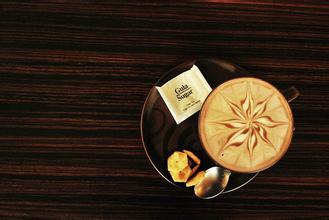"the unfinished Golden Milan Coffee time" starts broadcasting and conveys coffee culture by voice.

The first issue of Golden Milan Coffee time: Brazilian Coffee
Click Audio to listen >
Coffee beans live in the gentle countryside of Brazil.
[audio text and extended reading]
Narrator: Zhu Xuesong, founder of Golden Milan Coffee
Before talking about Brazilian coffee, I would like to talk about the impact of crops on the pattern of a country. Take China as an example. We may already be a large country with a population of 1.5 billion. But in the middle of the Ming Dynasty, there were only tens of millions of people in China. What made China a great country? This has a lot to do with the introduction of Chinese corn from South America at the end of the Ming Dynasty. With corn, China's limited land can grow more food, and these land can feed more people. By now, the number of these people's descendants has reached 1.5 billion. We had to put forward the family planning policy in the mid-1980s, and some post-80s friends lost the opportunity to have brothers and sisters. This reason, I think, may have something to do with corn.
Slaves in early coffee plantations
So what is the impact of coffee on Brazil? Of course, coffee gives Brazil foreign exchange earnings and solves people's life problems. But more importantly, you may not know that when the coffee spread to Brazil, Brazil was a very closed serfdom country, a colony controlled by the Portuguese government. The common people are working silently in this land, not knowing what is happening in the outside world. Then there was coffee, and this kind of thing was exported to Europe and the United States, so that people had a chance to learn about the outside world. Coffee is not only a kind of agricultural product, but also a channel to get information. When they know the fancy world outside, Brazilians are thinking: why can't we be independent? Why can't we set up a country of our own? Thus, in 1822, the monarchy was established by Pedro I. Sixty-seven years later, in 1889, they founded the Republic. Therefore, coffee not only brings income to the people and solves the problems of life, but also plays a great role in the social transformation of Brazil.
Yellow coffee fruit from Brazil
In 1727, when coffee beans were first planted in Brazil, they chose such a place, called Carmo de Minas, which was a very good place to grow coffee. There are low valleys and highlands, and the plateaus here are between 900m and 1200 m. With plenty of river water and Rain Water, it is a natural place to grow coffee. In 2014, I went to Carmo de Minas to find the coffee beans there. The breed I was looking for was called Yellow Bourbon. As we all know, the fruit of coffee is red, so the English name of coffee fruit is Coffee Cherry. However, this kind of coffee in Brazil is yellow. seen from a distance, it looks very much like an orange. I saw this yellow coffee fruit on a manor in Brazil, and it was treated in a very special way. Remove the peel and pulp, leave the pectin, and dry it on the vast Brazilian Hirado plateau, where abundant sunlight causes the pectin on the coffee beans to produce a very subtle and subtle fermentation, producing a very sweet substance. This sweetness goes back into the coffee beans, making Brazilian coffee, the Yellow Bourbon, sweeter and smoother. So its flavor is sweet and has the flavor of light cocoa peanut sugar. Golden Milan produced such a Brazilian coffee, which is called Brazilian pectin sun drying.
With the successful cultivation of coffee in the Carmo de Minas region, there were more and more places in Brazil, where coffee was an important crop. Brazil is now a big coffee producer with an annual output of 50 million bags, ranking first in the world, accounting for 1/3 of the world's total output. Brazilian coffee is not only productive, but it is a very peaceful and mild product that can be consumed independently or mixed with any other kind of coffee beans, showing great tolerance.
Important Notice :
前街咖啡 FrontStreet Coffee has moved to new addredd:
FrontStreet Coffee Address: 315,Donghua East Road,GuangZhou
Tel:020 38364473
- Prev

Coffee quality praised Cosco sales growth is difficult to match sterling decline import costs are expected to rise
FX168 Financial News (Hong Kong)-Whitbread, the owner of Costa, reported higher profits on Tuesday, and coffee connoisseurs appreciated its more refined caffeine preparation and brewing. But Whitbread fell sharply on the day amid expectations that the depreciation of sterling had pushed up the cost of restocking. The coffee chain opened for a year in the 26 weeks before September.
- Next

There is a little thing on the Starbucks menu. Will you be able to enjoy your coffee in the future? From this year
Starting from September 29 this year, the calorie number of all drinks sold in Starbucks Canada will be clearly marked on the in-store menu board, including various small / medium / large drinks, even with milk, cream and other condiments. Calorie count will be listed. At the same time, starting from November 2, all food sold in the store will be filled with corresponding calorie units. This is to drink Starbuck.
Related
- Why can American refills for free? The difference between Americano and American drip pot coffee
- Being chased out of the rain in front of Starbucks?! Store: Sheltering from rain under umbrellas poses a safety hazard
- The white moonlight has changed?! Lucky launches "Big Winter Pear American"
- Hand-brewed coffee three-stage method, high-sweet and universal brewing method to share! What does the high sweet water level of hand-brewed coffee mean?
- What is the difference between raw, refined and full espresso coffee? How to extract espresso and taste good?
- A complete list of coffee bean names and their meanings! What is Yejia Shefi coffee? Where is Mantelin coffee?
- What grade does Arida Manor Kaduai coffee beans belong to? What treatment is Arida ASD slow anaerobic sun exposure?
- The milk tea cup becomes smaller?! Overlord Tea Girl launches a new "Return to Yunnan" series
- Accused of selling counterfeit and high-priced coffee beans! Well-known boutique coffee brand "Oukelao" bowed and apologized!
- How to make espresso dumplings? Can I eat coffee and glutinous rice balls together?

